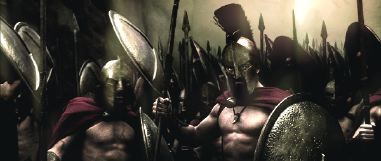Comic-book violence

The famous battle of Thermopylae, which took place in 480 BC between a massive Persian force led by the King Xerxes and a small band of Greeks headed by 300 Spartans and led by the popular King Leonidas is the subject of 300. Thermopylae (“Hot Gates”) was a narrow pass near a hot springs. The Greeks’ plan was not to defeat the Persians but to delay them long enough to be able to mobilize a larger army for a later battle. They succeeded, and defeated the Persians a year later at the Battle of Plataea. The Greeks in general and the Spartans in particular have long been celebrated for their boldness and courage in the face of impossible odds. As Frank Capra liked to say: What better cause to fight for than a lost cause?
300 is based on a graphic novel (a high-end comic book) by Frank Miller, who also penned the comic book-turned-movie Sin City. He was inspired to retell the tale of Thermopylae by a childhood experience of seeing the 1962 film The 300 Spartans (he was swept away by the idea of the good guys losing). The film is directed by Zack Snyder, a talented commercial and music videomaker who directed the well-received remake of Dawn of the Dead in 2004.
Critics have found lots to object to in 300—it’s too violent, historically inaccurate, lacking in subtlety, light on widescreen movement and prone to clunky dialogue. Politically the film has been seen as too pro-American, too anti-American or not political enough. Since ancient Persia is modern-day Iran, many viewers think the film must have a political agenda somewhere.
One could argue with these complaints, but that would miss most of what the makers of 300 were trying to do: create a film that resembles a comic book. It employs the same visual tools as a comic book, most notably in its use of static images. Instead of featuring sweeping camera moves or dramatic long shots to suggest the intensity of the action (as in Troy), 300 focuses on faces, the sound of the battle, or such memorable images as a tree littered with dead Greeks or a wall with dead Persians serving as mortar.
The impact of comic books (and they have played a big role in children’s unoffical education) has to do with the way each panel is conceived and suggests a point of view. Also, the size and scope of the dialogue must match the size and scope of the visuals, which pretty much precludes subtext and subtle insight. 300 is the sort of film that wears out the exclamation point on a screenwriter’s keyboard. The script doesn’t read, “Tonight, we dine in hell!” but “Tonight! We! Dine! In! Hell!!”
The violence is plentiful, as befits a movie about prolonged hand-to-hand combat with swords and spears (it is rated R), but it is the sort of comic-book violence that is not nearly as disturbing as the sadistic violence that shows up in most PG-13 slasher films.
Is the film historically inaccurate? Is the pope Catholic? Show me a sword-and-sandal movie that doesn’t play fast and loose with the known facts and I’ll show you a PBS documentary. Chances are pretty good that Xerxes didn’t have all sorts of piercings on his body, and there’s no reason to believe that the Persians employed elephants and rhinoceri in their cavalry. The Persian immortals, Xerxes’ best fighters, probably didn’t wear silver masks, and the regular troops most likely didn’t dress as ninjas. Plenty of other mistakes can be noted, but none is significant enough to affect the overall message of the tale. They just juice things up for the big screen. As a character says in John Ford’s masterful 1962 western The Man Who Shot Liberty Valance: “This is the west, Sir. When legend becomes fact, print the legend.”
The battle of Thermopylae no longer exists as mere fact. By now it even transcends legend, moving onto the ground of myth, where action and motivation seem guided less by soldiers and generals than by the gods, who are teaching lessons about courage, sacrifice and freedom.
A monument at the Thermopylae battle site quotes the historian Simonides: “Go tell the Spartans, stranger passing by, that here, obedient to their laws, we lie.” 300 has its flaws, but it carries that message well.





